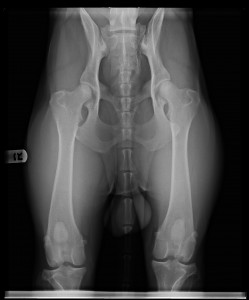The Truth About Hip Dysplasia
 Hip dysplasia is a common genetic problem among many large breeds of dogs, including German Shepherd Dogs. This condition affects the structure of the hip joint, and can range from being very mild to severe and crippling. While there is much information on hip dysplasia available, there are still many myths and half-truths surrounding the condition that continue to circulate among the general public and among many of the backyard breeders for German Shepherd Dogs (for more information on breeders, please see our blogs on Breeder Websites, Backyard Breeding, and Large-scale Commercial Breeding Operations.). In this blog, we will tackle some of the more common statements out there about hip dysplasia.
Hip dysplasia is a common genetic problem among many large breeds of dogs, including German Shepherd Dogs. This condition affects the structure of the hip joint, and can range from being very mild to severe and crippling. While there is much information on hip dysplasia available, there are still many myths and half-truths surrounding the condition that continue to circulate among the general public and among many of the backyard breeders for German Shepherd Dogs (for more information on breeders, please see our blogs on Breeder Websites, Backyard Breeding, and Large-scale Commercial Breeding Operations.). In this blog, we will tackle some of the more common statements out there about hip dysplasia.
Statement: Hip dysplasia isn’t that big of a deal; it is just a little arthritis in the hips
Truth: Hip dysplasia is a problem with joint formation first, that can then lead to extensive arthritis.
The Orthopedic Foundation for Animals, the leading authority in the U.S. on orthopedic conditions like hip and elbow dysplasia, states:
Hip Dysplasia is a terrible genetic disease because of the various degrees of arthritis (also called degenerative joint disease, arthrosis, osteoarthrosis) it can eventually produce, leading to pain and debilitation. (www.offa.org/hd_info.html)
Arthritis is always secondary to the dysplasia. With dysplastic hips, the actual structure of the hip joint is affected. The ball of the femur does not fit well in the socket on the pelvis, either because the socket and the ball are deformed, or there is excessive laxity or looseness in the fit. This results in excessive movement of the femur against the socket as the dog moves, which creates the inflammation that eventually will lead to arthritis. As the dog ages and loses some of the muscle mass that helps stabilize the hip joint, movement becomes more difficult, and can be incredibly painful or even debilitating for the dog.
Statement: “My vet looked at my dog and said his hips are just fine.”
Truth: Hip dysplasia can ONLY be conclusively proven by x-ray.
Hip dysplasia (HD) is a disorder of the hip joint itself. We must look at the actual morphology of the hip joint, how the hip socket and head of the femur fit together. This cannot be done by simple visual inspection of the dog’s physical appearance during a visit at the vet’s office, so unless the vet has x-ray vision, a statement of “hips seem fine” has very little merit in terms of diagnosing hip dysplasia. Severe hip dysplasia can often be ‘diagnosed’ by observing the dog’s movement, uneven muscle development, and hind end weakness, but must be conclusively determined via x-ray. Mild and moderate HD will often present few signs until later in life.
Statement: “There has never been any indication of hip dysplasia in my dog/dogs; therefore, their hips are fine.”
Truth: Again, hip dysplasia can only be conclusively determined by x-ray.
Without x-rays, mild and moderate HD will often go unnoticed and undiagnosed until the dog is older, at which point problems with running, jumping, rising after laying down, etc. develop. Most owners contribute it to arthritis and old age, even if the dog is only middle aged. This “no indication of hip dysplasia” excuse is used by those breeders and individuals who avoid x-raying their breeding dogs prior to breeding them. Then, when the dog is older and starts showing signs of dysplasia, the problems are just chalked up to “old age”. Again, the ONLY way to prove hips are free of dysplasia is through x-rays.
Some breeders claim their dogs all have excellent hips because their parents and grandparents never showed any signs of hip dysplasia and therefore they are “clear” by parentage. Unfortunately, this is just wishful thinking. Why? Because of the complicated nature of hip dysplasia inheritance.
Hip dysplasia is a polygenic trait, meaning it is controlled by multiple genes. This creates a more complicated inheritance pattern, allowing recessive alleles to “hide” and skip generations. This is how two normal parents can still produce offspring with hip dysplasia, if that particular puppy happens to receive defective genes from both parents. The more defective genes a dog inherits, the greater the likelihood of developing hip dysplasia. HD is not like Degenerative Myelopathy, where only one gene is involved and thus a dog can be clear by parentage (if parents are both normal, the dog will only be able to inherit a normal copy of the DM gene). Thus, every breeding dog must itself be x-rayed in order to prove they have good hips, rather than relying on the parents’ hip ratings alone.
Statement: “Hip dysplasia is environmental, not genetic.”
Truth: Hip dysplasia has both genetic and environmental factors.
The bulk of the hip dysplasia disorder is genetic. However, environmental factors can play a role in the development and severity of hip dysplasia. Improper nutrition, trauma, and abnormal growth during the time the bones are developing are factors that can contribute to the development of hip dysplasia. The higher the genetic load (having a higher number of defective genes) within a dog, the less environmental factors are needed to result in the formation of hip dysplasia. The lower the genetic load, the greater environmental factors the dog can handle. More information on the relationship between polygenic traits and the environment can be found here.
Statement: “It’s only crippling HD that’s the problem; there’s no reason why a mildly dysplastic dog can’t be bred.”
Truth: A dog with mild HD shows they have more of the genes for hip dysplasia, which they will then pass on to their offspring, resulting in increasingly severe HD in successive generations.
But because HD is a polygenic trait, a dog with mild hip dysplasia is already demonstrating conclusively that they possess a higher genetic load than a dog with normal hips. Thus, in breeding a dysplastic dog, the offspring are receiving a higher percentage of the defective genes, which then increases their “genetic load”. The genes for dysplasia are being passed on, and can result in severe HD in successive generations as more of these genes accumulate.
For example, let’s say HD is controlled by two different genes (in reality, there are more genes than this, creating a more complex picture of inheritance. Two is the number chosen for illustrative purposes). A mildly dysplastic dog has three out of four defective alleles for the two genes controlling the formation of the hip joint (Each dog inherits two copies, or alleles, of the gene from each parent). If this dog is bred, then every single offspring will receive at least one defective allele.
 Let’s say this dog with mild hip dysplasia (with a genotype of, say, aaBb for hip genes) was bred to a dog with normal hips. This dog with normal hips could still be heterozygous for the genes controlling the formation of the hip, meaning this normal dog can still possess a defective allele or two. For illustrative purposes, let’s say this dog with normal hips has a genotype of AaBb. The cross for this breeding is shown in the Punnet square on the right. This breeding of a dysplastic dog with a normal dog will result in a percentage of the puppies having two normal and two defective alleles, or three normal alleles and one defective allele (so, some pups will have normal hips), and the rest of the puppies having either three out of four defective genes, or all four defective genes (which, for this scenario, would result in SEVERE hip dysplasia). Given the probabilities of inheritance, at least half of the litter could have moderate to severe hip dysplasia! In other words, breeding a dog known to have dysplastic hips–even mildly dysplastic hips–will continue to perpetuate and even accumulate the defective alleles in the offspring, and in the population as a whole.
Let’s say this dog with mild hip dysplasia (with a genotype of, say, aaBb for hip genes) was bred to a dog with normal hips. This dog with normal hips could still be heterozygous for the genes controlling the formation of the hip, meaning this normal dog can still possess a defective allele or two. For illustrative purposes, let’s say this dog with normal hips has a genotype of AaBb. The cross for this breeding is shown in the Punnet square on the right. This breeding of a dysplastic dog with a normal dog will result in a percentage of the puppies having two normal and two defective alleles, or three normal alleles and one defective allele (so, some pups will have normal hips), and the rest of the puppies having either three out of four defective genes, or all four defective genes (which, for this scenario, would result in SEVERE hip dysplasia). Given the probabilities of inheritance, at least half of the litter could have moderate to severe hip dysplasia! In other words, breeding a dog known to have dysplastic hips–even mildly dysplastic hips–will continue to perpetuate and even accumulate the defective alleles in the offspring, and in the population as a whole.
Statement: “All GSDs have bad hips/will get hip dysplasia as they age.”
Truth: Absolutely false.

If anyone owns a German Shepherd, they will undoubtedly hear this statement from other people who know little about the breed (or who think they know a lot about GSDs because they had one, once). People often witness the angulation of the rear legs and the motion of their walk, and assume that the dog has hip dysplasia, even when the dog does not. This is “verified” by many of the overbred American and German show line dogs, who may have such severe angulation that it creates a very odd “frog-like” walk. This is created by the change in the length of the stifle and the positioning of the croup, not necessarily by the morphology of the hip joint itself. These dogs may still show normal hips via x-ray, and in fact many of them do have “a” normal hips. But the difference in their structure and the way they move has created this myth that “all GSDs have bad hips.”
German Shepherd Dogs will not suddenly “develop” hip dysplasia as they age. They may get arthritis in their hips or in the lumbosacral region of the spine, but this is not to be confused with dysplasia (malformation of the actual hip joint). Many people believe their dogs have “good hips” (not verified by x-ray), when they may actually have mild or moderate dysplasia that starts revealing itself as the dog hits six, seven, or eight years of age. The laxity of the hip joint and the improper fit of the ball and socket have created arthritic changes that now are manifested as pain, stiffness, and uneven muscle development as the dog alters its gait to protect the most painful joint. Arthritis develops over time, until it finally is painful enough for the dog to show it. Thus, the arthritic changes began years ago, created by the poor morphology of the hip and the excessive laxity (looseness) that has allowed the bones to bump and grind and move excessively. But since this does not show until the dog ages, the belief becomes that the dog “developed bad hips in old age”. In reality, the dog has always had bad hips, but is just now showing it. A dog with good, tight hips will age better with much less arthritis overall; there are many GSDs with good hips who are still running and jumping and even working well into their golden years!
The truth of the matter is that anyone wishing to breed their dog should x-ray both hips and elbows first and certify them with OFA or the SV, to conclusively prove that their dog is free of hip and elbow dysplasia. And puppy buyers should ensure that their potential breeder has valid hip and elbow certificates for their dogs. Hip ratings can be checked on the OFA database; if a breeder’s dogs do not show up in the database, ask to see proof of valid hip ratings.

